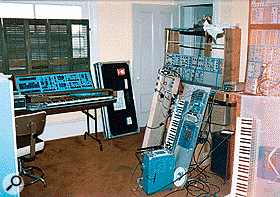 E-mu Systems was a US, Silicon Valley-based, synthesizer manufacturer. Early on this company produced audio interfaces, from MIDI interfaces to MIDI keyboards as well. E-mu Systems was founded in Santa Cruz, CA by Dave Rossum, a UCSC student and two of his friends from Caltech, Steve Gabriel and Jim Ketcham, and later Scott Wedge with the goal to build their own modular synthesizers. In 1972, E-mu became a company, developing and patenting a digitally scanned polyphonic keyboard. Founded in 1971 as a synthesizer maker, E-mu was a pioneer in samplers, sample-based drum machines, and they revolutionized the industry with low-cost digital sampling music workstations. E-mu was last based in this building (seen above) in Scotts Valley, California, on the outskirts of Silicon Valley.
E-mu Systems was a US, Silicon Valley-based, synthesizer manufacturer. Early on this company produced audio interfaces, from MIDI interfaces to MIDI keyboards as well. E-mu Systems was founded in Santa Cruz, CA by Dave Rossum, a UCSC student and two of his friends from Caltech, Steve Gabriel and Jim Ketcham, and later Scott Wedge with the goal to build their own modular synthesizers. In 1972, E-mu became a company, developing and patenting a digitally scanned polyphonic keyboard. Founded in 1971 as a synthesizer maker, E-mu was a pioneer in samplers, sample-based drum machines, and they revolutionized the industry with low-cost digital sampling music workstations. E-mu was last based in this building (seen above) in Scotts Valley, California, on the outskirts of Silicon Valley.
In this picture, you can see Emu’s first office at Broadway, in Santa Cruz, from December 1980. The early versions of Audity synthesizer (on the left), and the Emulator synthesizer can be seen (floor in the foreground) in this picture.
In late 1980, the team developed a polyphonic eight-voice sampler (which can be seen in the picture of the Emu headquarters in late 1980). The first customer shipment went to Stevie Wonder in June 1981. The Emulator I was available as both an eight- and four-voice model with 128kB of sample memory. It is said, another 25 customers bought the sampler that year since sampling was still in its infancy, and only a few artists utilizing its capability. It took another year before it’s sound was used to propel records as Paul Hardcastle’s ’19’ up the charts in 1981.
The company later redesigned the Emulator, created a factory sound library of over 100 diskettes, added a built-in sequencer, and cut the price by 20 percent. The updated and redesigned Mark 2 Emulator I became a hit, selling over 400 in a couple of years.
In the early ’80’s there was a rapid rise in popularity of digital drum machines from Linn and Oberheim costing over $2500. In 1982 Emu Systems discovered how to take advantage of the market by developing a basic digital drum machine available for just $995. Dave Rossum was able to improve on the existing designs by implementing new ideas on sample replay, and by sharing components to cut costs.
The result was the Drumulator that came out in 1983, after a short and successful development project. It sold very well and reached sales of 10,000 in over two years. By 1984, the competition caught up and sales began to drop as the more powerful Oberheim DMX, and a drove of Japanese MIDI drum machines like the revolutionary Roland TR909 emerged. (Via David Grandison)
Hip Hop’s Romance With The E-mu SP-1200 Changed the Game
In 1987, the E-mu SP-1200 made creating music on a single portable machine possible for the first time. The choppy lo-fi beats produced by this drum machine created a sound reminiscent of classic rap albums in the late 1980s and early 1990s. The SP-1200s four memory banks enabled users to combine multiple sample loops and simulated several pieces of equipment, thus lowering studio costs. Independent producers with inexpensive budgets could produce more complex beats in the comfort of their home. A pioneer of its type, the SP-1200 was a state-of-the-art must-have for producers alike, led to the emergence of independent labels, and enabled more creative freedom for artists. This sampler would introduce the world to sampling’s potential and influence during the golden era of Hip Hop. The SP-1200 was a go-to drum machine & sampler combo that reached legendary status among old school rap and hip hop artists from the eighties and nineties.
One of the keys to its appeal was the dirtiness of the sound. It became a key component to hip hop and house music grooves in the 80’s and 90’s. They say it sounded like “old vinyl”…and this piece of gear featured groove quantizing it has limited sampling specs: 26.040 kHz and 12-bit resolution and a disk drive for sample storage.
(Hip Hop’s Romance With The E-mu SP-1200- Contributed by Xavier Sharif Galloway a writer from The Clive Davis Institute x Billboard MUSIC INDUSTRY ESSENTIALS program)

